A selection of varieties of climbing roses
| Content:
|
A special place among roses is occupied by climbing roses, which are planted as hedges, as decoration for balconies, terraces, verandas, loggias and gazebos, as decoration for arches and trellises.They are able to bring nobility and luxury to any, even the most abandoned and inconspicuous corner of the garden.
The main advantages of climbing roses are their unpretentiousness and resistance to temperature changes.
Climbing roses are divided into two main groups:
- small-flowered - ramblers;
- large-flowered - climbers.
The difference between these plants is based not only on the size of the buds, but also on the location of their appearance. Ramblers flower on last year's shoots, and climbers flower on last year's and young shoots.
Ramblers call "true" climbing roses. The stems of such shrubs are more flexible, and the height is 5-10 meters. Almost all varieties bloom once, but the flowering is abundant and lasts a month.
Climbers are repeat flowering plants. They are decorated with large flowers or inflorescences and rigid branches up to 3 meters long.
Both types of climbing roses look great. Climbers, thanks to large flowers, and ramblers, thanks to the abundance of medium and small flowers. Descriptions and photos of the most beautiful varieties of climbing roses are presented below.
Varieties of climbing roses that bloom all summer
Among the many types of plants, gardeners always highlight the rose, the unsurpassed queen of the garden. Flower growers especially highlight varieties of continuously blooming roses to admire from spring to autumn. Flowering throughout the entire summer season, and sometimes part of the autumn season, is typical for the group of climbing roses, among which there are many varieties with repeated and continuous flowering.
Elf
|
An amazing rose with creamy vanilla flowers in a nostalgic shape. |
It has a strong fruity aroma and blooms throughout the summer.The variety belongs to the group of climbers.
- The length of the lashes reaches 3 meters. The shoots are straight, strong, numerous, covered with large thorns.
- The flowers are white with a green tint, double, cup-shaped. At the stage of complete dissolution, they reach a diameter of 8-14 cm, while the middle is not visible. Clusters of 3-5 buds are formed on strong peduncles. Each flower consists of 40-60 petals. Fruity aroma.
- Rose Elf is distinguished by continuous long flowering from the first days of June to September. Flowers lose their attractiveness due to rain and gusts of wind. In the scorching sun, burns of the petals are possible.
- Resistance to powdery mildew and spotting is high.
- The plant prefers fertile loamy soils, light, loose and breathable, with a neutral or slightly acidic reaction.
- Choose a sunny place for planting with midday shade.
- Frost resistance: -20°C (zone 5). It can be grown in central Russia, including the Moscow region.
Salita
|
The Salita variety attracts attention with its bright scarlet lush inflorescences. |
An attractive feature is that the bush blooms continuously. The buds bloom one by one over the entire surface of the green mass of the climbing rose. Salita belongs to the group of climbers.
- The spreading bush can grow up to 3 meters in height and 1.5 meters in width. The shoots are strong. The leaves are large, matte, dark green.
- Salita flowers are bright scarlet with an orange tint, double type. The shape of the flowers is classic, with a diameter of 9 cm. 2-5 buds are formed on the stem, consisting of 40 petals. The aroma is light, fruity.
- Flowering continues all summer, from June to October. The variety tolerates long periods of precipitation well.
- The planting location is chosen in the sun with protection from cold winds.The soil is preferably loose, moisture- and breathable.
- The Salita variety has average immunity to most fungal diseases. Preventative measures are required.
- Climate zone: 6 (from -26°C to -18°C). Suitable for breeding in the northern regions of Russia: Moscow, Leningrad, Smolensk, Tver regions, Middle Volga region, Urals.
Florentina
|
The climbing rose Florentina is a continuous flowering flower. |
An excellent variety with lush flowering, suitable for the climate of the Moscow region.
- Scourges grow up to 2-3 meters. Crown width 1 meter. The stems are thick, strong, and easy to shape. The leaves are large, dark green, glossy.
- The flowers are densely double, consist of 40-60 petals, sometimes a yellow core is visible. Diameter 8-10 cm. Cup-shaped. The buds are formed in brushes of 20 pieces. The color of the petals is classic red. The aroma is weak, floral and fruity.
- Flowering lasts from June to September, up to 100 flowers appear per season. The buds do not fade in the sun, and after rain there are no streaks left on the petals.
- The planting site should be low groundwater and well lit. The Florentina variety grows very well in loams and black soils. The soil composition should be slightly acidic.
- This variety is susceptible to powdery mildew and black spot. It is impossible to do without regular preventive treatments.
- Frost resistance zone: 4 (from -34 to -29°C).
Don Juan
|
Rose Don Juan belongs to the group of large-flowered climbers. It is resistant to rain and highly decorative. |
The plant is suitable for group plantings and vertical gardening, and can also be used for cutting.Gardeners near Moscow value it for its easy care, frost resistance, and abundant flowering.
- This is a perennial ornamental plant reaching up to 3 m in height and about 2 m in diameter. The plant has strong, straight shoots covered with large thorns. The foliage is leathery, with a shiny surface, emerald green.
- Flowers, 9-11 cm in diameter, double, cup-shaped. There are about 30-40 petals in such a bowl. The buds are formed singly or collected in small inflorescences. The color of the flowers is bright red. The aroma is pleasant, floral and fruity.
- Flowering lasts from June to November.
- For planting, it is better to choose well-lit places, protected from cold winds.
- The plant has good resistance to powdery mildew and black spot.
- Frost resistance: -20°C (zone 5). In regions with cold winters, plants are advised to be covered.
Santana
|
A distinctive feature of the Santana rose is the deep red color of the inflorescences with a velvety tint that does not fade even under the scorching rays of the sun. |
The bush is covered with flowers evenly. The variety is unpretentious in care and grows well both with and without support.
- The length of the lashes is 2-3 meters. The crown spreads 2 meters in width. The shoots are erect and strong. The leaves are large and leathery.
- The flowers are semi-double, 8-12 cm in diameter. Cup-shaped. One brush contains 3–7 buds of rich red color. The aroma is weak. When cut, the flowers remain fresh for a long time.
- The Santana rose blooms for a long time, from June to October. Flowers do not lose their beauty when exposed to bad weather.
- To grow Santana roses, experts advise choosing elevated and well-lit areas, without drafts. It is advisable to place seedlings in the southern or southwestern part of the garden.The variety prefers light, nutritious, well-drained soils with neutral acidity.
- Resistance to powdery mildew and black spot is high.
- Winter hardiness zone: 4 (from -34 to -29°C). Feels great in gardens in the Moscow region and Leningrad region.
Laguna
|
The climbing rose Laguna with a long flowering period belongs to the German rose collection. Flowers remain fresh for a long time when cut. |
The peculiarity of the variety is its very high resistance to black spot and other fungal diseases.
- The lashes grow up to 2.5 meters in height and about 1 meter in width. The shoots are strong and prickly. The leaves are medium sized, glossy.
- Flowers are 10 cm in diameter, densely double, consisting of 40-50 petals. Each flower lasts on the bush for about 10 days. The buds are collected in brushes of 6-8 pieces. The petals are velvety, bright pink. The aroma is complex: contains notes of lemon, lychee, mandarin, Bourbon geranium, patchouli and rose.
- The bush is distinguished by long and abundant flowering, which continues throughout the summer.
- The culture grows well in sunlit areas and thrives in partial shade.
- The climbing rose Laguna is practically not susceptible to pests and rarely gets sick, but it is vulnerable to spider mites and aphids.
- Winter hardiness zone: 4 (from -34 to -29°C). The variety does not need shelter for the winter.
Indigoletta
|
The Indigoletta rose has flowers of an unusual color - lilac-lilac. The variety is distinguished not only by the rare shade of its petals, but also by the massiveness and double size of its flowers. |
The optimal region for cultivation is central Russia. Indigoletta belongs to the group of large-flowered climbers.
- The length of the shoots reaches 3 meters. The crown spreads up to 1.5 meters in width.The vines are powerful, the leaves are dark green. The bush is characterized by rapid growth.
- The flowers, 8-10 cm in diameter, consist of 25-30 petals and are saucer-shaped. The aroma is strong and pleasant.
- Flowering is continuous throughout the season.
- In direct sunlight there is a possibility of petals burning out. The variety is resistant to high humidity and strong winds.
- The Indigoletta rose grows best in fertile, loose and well-permeable soil.
- Frost resistance: -20°C (zone 5). The variety will overwinter without shelter at a temperature of -20 °C.
Varieties of red climbing roses
Red climbing roses are popular for their vibrant color and beautiful blooms. They will add bright colors to the landscape of the site, hide flaws and emphasize advantages.
Paul's Scarlet
|
Rose Paul Scarlet is famous for its ease of care. It is convenient to trim the plant and give it the desired size. |
The description of this rose suggests that it is one of the most unpretentious climbing varieties; growing it is a pleasure.
- Bush, 3 meters high, spreading, highly branched, with thick shoots and small thorns. Growth is active, so the culture needs support.
- The flowers are double, cup-shaped, consist of 24 petals, painted in bright crimson and cherry tones. The buds are collected in brushes of 3-15 pieces.
- The diameter of the blooming flower is 5-7 cm. The aroma of the variety is light and delicate.
- Paul's Scarlet blooms in waves, the first wave being the most abundant. The petals are not afraid of either heat or rain.
- The culture tolerates poor soils and partial shade.
- The climbing rose Paul Scarlet is disease resistant.
- Frost resistance: -20°C (zone 5). The variety is excellent for regions of both the southern and middle zones.
Amadeus
|
A beautiful variety of climbing rose, blooming in waves with large red flowers with a bright aroma. |
It is also highly resistant to diseases, pests and adverse weather conditions.
- The height of the lashes reaches 3 meters. The crown width is 2 meters. The shoots are powerful and do not require additional support. The leaves are dark green. The spines are numerous, curved, and sharp.
- The flowers are large, 12 cm in diameter, goblet-shaped. Each flower consists of 42 petals. Lush inflorescences consist of 7 buds. The petals are velvety, rich red in color. The aroma is sweet, pleasant, with notes of cherry, apricot and raspberry.
- The first wave of flowering occurs in June and lasts almost 1.5 months. Before the second wave begins, single flowers appear. Rose Amadeus is a decoration of the garden until autumn. At the same time, it exhibits high resistance to bad weather and, in particular, to rain. The petals do not fade in the sun.
- The planting site should be sunny and ventilated. The soil is suitable loose, with good water permeability.
- Resistance to black spot and powdery mildew is very high.
- Winter hardiness zone: 4 (from -34 to -29°C).
Baikal
|
The Baikal variety is endowed with many advantages: good immunity, winter hardiness, abundant and long flowering, highly resistant to fading, winds and rains. This is a bright representative of large-flowered climbers. |
- The length of flexible lashes is 2-3.5 meters. The culture is characterized by good branching. Due to this, the bush looks voluminous, the crown width is about a meter. The leaves are dark green, the thorns are sharp.
- Roses have a double structure and consist of 30-35 petals. The diameter of the flower is 7-9 cm. The color of the petals is uniform - bright red or light ruby.Flowers are formed into inflorescences. The aroma of blooming roses is weak, but very pleasant, with sweet and fruity notes.
- The climbing rose Baikal is famous for its abundant flowering from mid-June to the end of October; it belongs to the group of repeat bloomers. Shows good resistance to prolonged rains, but is susceptible to the scorching sun.
- The plant prefers fertile loamy soils, light, loose and breathable, with a neutral reaction. Choose a sunny place for planting.
- The variety has average resistance to black spot and powdery mildew. Preventive treatments should not be neglected.
- Frost resistance: -20°C (zone 5).
Flammentanz
|
The variety was bred in the fifties of the 20th century, but is still loved by flower growers. Valued for its unpretentiousness and decorativeness. |
Thanks to this, the Flammentanz rose is widespread in all regions of Russia, including the Moscow region.
- The length of the lashes reaches 4 meters. It is recommended to grow roses with support. The leaves are large, dark green.
- The flowers are dark crimson, double. The diameter of each is 8-9 cm. The inflorescences consist of 10 buds, which are formed on the shoots of the previous year, as they belong to ramblers. The aroma is delicate, weak.
- Flowering is one-time, but long-lasting, more than a month. Rosa Flammentanz tolerates climates with short summer periods.
- Grows well in sun and partial shade. Prefers fertile, light, loose and breathable soils with a neutral reaction.
- It has good immunity, but in some cases after flowering it is affected by black spot.
- Winter hardiness zone: 4 (from -34 to -29°C). The plant can overwinter without shelter down to -24°C.
Sympathie
|
Climber Sympathie is valued for its large bright red flowers, abundant flowering, great vigor and unpretentiousness. |
The variety is planted near gazebos, fences, and country houses.
- The shoots of the Sympathy rose extend from 2.5 to 4 meters in length. The bush is branched, 2 meters wide, the foliage is bright green and shiny.
- The flowers are double, large, 10–12 cm in diameter, goblet-shaped. The color of the petals is bright red. The buds are collected in brushes of 3-10 pieces. The aroma is barely noticeable.
- Flowering occurs in waves, from June to October. Each subsequent wave is less abundant than the previous one. The flowers hold tightly during wind and rain.
- The plant is not picky about soil; it prefers to grow in sunny places.
- The variety is resistant to diseases. Young shoots suffer from aphids.
- Winter hardiness zone: 4 (from -34 to -29°C).
Varieties of white roses
White climbing roses are the most elegant among other types of roses. White color fills the garden with freshness and solemnity and goes well with any other plants.
Iceberg
|
This is one of the best varieties among white climbing roses. |
A magnificent bush, abundantly covered with snow-white flowers, resembles a huge iceberg. Keeps well when cut.
- The length of the lashes reaches 1.5-2.5 m, the width of the crown is 2 m. The shoots grow quickly.
- The flowers are double, milky white, the diameter of one flower is 8-10 cm. The roses are collected in inflorescences of 2-3 pieces. The aroma is weak, sweetish honey.
- In the regions of central Russia, flowering lasts throughout the whole season. Rain resistance is average.
- Iceberg prefers a sunny growing location. The soil should be prepared drained and nutritious.
- Under unfavorable weather conditions, Iceberg may be susceptible to spotting and powdery mildew.
- Frost resistance: -20°C (zone 5).
Mrs. Herbert Stevens
|
Clymber Mrs. Herbert Stevens has been a favorite among gardeners and landscape designers for 100 years. |
A distinctive feature is the powerful bushes that grow quite quickly. The variety is used for decorating fences and walls, and designing mixborders.
- The width of the bushes reaches 2.5 m, the length of the lashes is 3-4 m. The shoots are thin, the leaves are light green, there are few thorns.
- The flowers are snow-white or slightly creamy, 10 cm in diameter. The petals are thin with a wavy edge. The aroma of tea rose will not leave anyone indifferent.
- The climbing rose Mrs. Herbert Stevens is characterized by repeated blooms throughout the season.
- The culture is unpretentious to growing conditions and can grow on poor sandy soils. But loamy soil with a neutral acidity level is best suited for it.
- Disease resistance is high. May be attacked by harmful insects.
- Frost resistance: -20°C (zone 5).
Snow Goose
|
A low rambler with small flowers similar to daisies. Unlike many ramblers, it pleases with repeated flowering. |
- The lashes grow up to 2.5 meters long. The crown is 1.5 meters wide and is easy to form. Stems are straight and flexible. The leaves are small, dark green, glossy. There are few thorns.
- The flowers are white with a cream tint and narrow petals of uneven length. In the sun, the petals fade and become snow-white. In one brush, 5-20 semi-double flowers with a diameter of 4-5 cm are formed. The aroma is light, with sweet notes.
- Flowering repeats until late autumn.Flowers fade when exposed to sunlight.
- Grows well in sun and partial shade.
- High resistance to powdery mildew and other diseases.
- Frost resistance: -20°C (zone 5).
Schneewalzer
|
The elegant and decorative Schneewaltzer rose stands out for its snow-white pearl color and regular shape. |
The advantages of this variety are: winter hardiness, strong immune system, abundant and beautiful flowering, unpretentiousness.
- The length of the lashes reaches 2-3 meters. In the southern regions, the rose grows up to 4 meters. The leaves are dark green, large, disease resistant. The bush branches well and forms a lush crown up to 2 meters in diameter in the second year after planting. There are a small number of thorns.
- The flowers are pure white, densely double, 14-16 cm in diameter. Cup-shaped. Each flower consists of 50 velvet petals. Buds are formed singly and in inflorescences. Each inflorescence has 3-7 buds. The blossoming flower shows a yellow center. The aroma is weak, with notes of citrus and berries. In addition, the lifespan of an individual rose is very short - 4-5 days, and in extreme heat even less - no more than 3 days.
- The Schneewalzer climbing rose blooms in two or three waves from late May-early June to October. The first one is the most abundant. The breaks between flowering are almost imperceptible.
- The culture does not tolerate rainy weather, during which the petals stick together and the buds do not open at all. In the sun, the petals fade and the plant can get burned.
- The plant prefers soil that is light, nutritious, moisture-absorbing, and slightly acidic.
- Frost resistance: -20°C (zone 5).
Yellow varieties of climbing roses
Yellow roses always attract the eye and give a good mood.Descriptions of varieties and photos of climbing roses with yellow flowers will help you choose the best specimen for your site.
Golden Showers
|
The graceful climbing rose Golden Showers is distinguished by its shade tolerance, early and long flowering. |
A fast-growing plant, the first flowers appear in the second year.
- The height of the lashes reaches 3 meters and cannot grow without support. The crown is spreading, 2 meters wide. The leaves are glossy, dark green.
- The flowers are semi-double. The base color can vary from lemon to cream depending on the amount of sunlight. The diameter of one flower is 8-10 cm. 3-5 buds are formed in the inflorescence. The aroma is weak, floral.
- Flowering is long, from June to October, with the largest number of buds appearing at the beginning of the season. Average resistance to precipitation.
- A variety of graceful climbing roses, Golden Showers, blooms profusely in sunny areas and in partial shade, and tolerates short-term absence of sun. The culture feels comfortable in acidic soil.
- To protect against diseases and pests, preventive measures are necessary.
- Frost resistance: -20°C (zone 5).
Golden Gate
|
A beautiful bush with large golden yellow flowers. |
Characterized by rapid growth, unpretentiousness, and winter hardiness. Can be grown for cutting.
- The length of the lashes is 4.5 meters. The bush is lush, with glossy green leaves. The shoots are medium thick, with thorns. They can grow without support. The leaves are dense, matte.
- The roses are golden yellow, velvety, 10 cm in diameter. Each consists of 50-60 petals. Buds are formed in brushes of 5-10 pieces. The aroma is fruity with notes of lemon and reveals itself in the evening.
- Repeated flowering. Flowers lose their decorative effect when exposed to sunlight and prolonged rains.
- Resistance to diseases and pests is average. Protection is needed.
- Climate zone: 5 (-24°C). The plant is covered for the winter.
Gold Stern
|
One of the best yellow climbing roses. Climber of German selection with bright yellow double flowers. |
The Goldstern variety is unpretentious, tolerates heat and cold well, and is resistant to disease.
- The bush forms powerful shoots up to 1.5-2 m tall. Can grow without support. The shoots are arched, drooping. The leaves are small.
- Flowers, 8-10 cm in diameter, double, cup-shaped, open to reveal yellow stamens. The petals are deep yellow, then fade to lemon yellow at the edges. Buds appear one at a time or in small inflorescences.
- Flowering is abundant and repeated. The first flowering is abundant, then individual flowers appear until frost. The flowers are resistant to rain and fading.
- The soil should be fertile and moderately loose. Partial shade with ventilation is suitable for planting.
- Preventative treatment is necessary for possible diseases.
- Frost resistance: -20°C (zone 5).
Rimosa
|
During the flowering period, the shoots of the climbing rose Rimosa are abundantly covered with bright lemon flowers, the green foliage is almost invisible. |
Looking at the photo, you can be convinced of this. The variety is widespread in Russia. Keeps well when cut.
- The length of the lashes grows up to 2 meters. The crown is wide. The shoots are strewn with small thorns. The leaves are dark green, glossy, dense.
- The flowers are double, bright yellow, fade slightly to a soft lemon shade. Inflorescences consist of 5-10 buds. The diameter of the flower is 7-9 cm. The shape is cup-shaped. The aroma is weak, fruity, with light notes of sour citrus.
- Flowering is continuous, abundant, from June to October. High resistance to rain. The buds bloom normally after a period of precipitation.
- In the bright sun the petals fade. The rose also does not tolerate very strong heat and cold very well.
- It is recommended to plant Rimosa in the sun. The soil will be acidic, black soil or regular.
- The variety is rarely affected by powdery mildew, even if other plants in the garden are affected.
- Frost resistance: -20°C (zone 5).
Casino
|
The photo shows the “Casino” rose. Climber with highly developed shoots. |
The Casino variety is valued for its abundant repeat flowering, resistance to infections, and unpretentiousness. Gives lush flowering in the middle zone.
- The bushes look decorative. The length of hard shoots is 3 meters. The spines are large. The foliage is glossy, dark green, large, disease resistant.
- The flowers are densely double, the inner petals are more intensely colored, the outer petals are lighter. Up to 4-5 flowers are formed in the inflorescence. The petals are painted in lemon-yellow shades. The aroma is rich fruity.
- Blooms abundantly, repeatedly, until frost. Lasts intermittently from June to October.
- The culture is highly resistant to fungal diseases.
- Frost resistance: -20°C (zone 5). The variety needs shelter for the winter.
Pink varieties
Pink climbing roses are a popular choice for the garden because of their delicate and romantic blooms. They can add elegance to garden walls, fences, arches or pergolas.
Jasmina
|
Delicate graceful flowers, collected in lush brushes, delight with the ideal shape of a densely double flower and a sweet fruity aroma. |
- The height of the bush is 1.9-2.5 meters. The crown grows up to 1 meter in width. The lashes are thin but strong, densely covered with sharp thorns. The leaves are green, glossy.
- The flowers are double, 7 cm in diameter, densely packed with petals, up to 70 pieces. When fully bloomed, the center of the flower is not visible. The shape of the Jasmina rose is “nostalgic”, cupped.The color is lavender pink. Up to 15 buds are formed on one brush. The aroma is floral and fruity.
- Repeated flowering lasts from June to September.
- The plant has good immunity.
- Frost resistance zone: 4 (from -34 to -29°C). It tolerates frost well and can grow in open ground in regions with harsh climates.
Pink Pearl
|
The climbing rose Pink Pearl is distinguished by curly shoots, bright velvet inflorescences, and has buds of unusual shape. |
The variety is often used to decorate garden landscapes in the classic English style.
- The rose reaches a height of 3 meters. Culture needs support.
- The flowers are double, small, 4 cm in diameter. The inflorescences consist of 5-10 buds. The petals are bent and tucked down. The color of the petals varies from bright pink to pale salmon. The aroma is light, unobtrusive.
- Repeated flowering lasts from July to October.
- Planting is carried out in sunny areas of the site. Rose Pink Pearl does not like shady areas. It is also worth taking care of protection from drafts in the area. The most suitable region for cultivation is Central Russia.
- The culture has good immunity and resistance to pests.
- Pink Pearl has good frost resistance; the inflorescences can withstand frosts up to 30 degrees. Winter hardiness zone: 4 (from -34 to -29°C).
Super Dorothy
|
Just look at the photo to fall in love with these roses. The riot of pink color will not leave anyone indifferent. |
The variety has deep bud color, a long flowering period and increased immunity to diseases and pests. The climbing beauty belongs to the group of ramblers.
- The length of the flexible lashes is 2-3 meters, the width of the bush reaches 2 meters. The shoots easily wrap around the support and take its shape. The leaves are small and green.There are few thorns. The bush is growing quickly.
- The flowers are small, voluminous, saucer-shaped, with a well-filled middle. The diameter of the flowers is 4-5 cm, they consist of 17-25 petals. Inflorescences consist of 5-10 buds. The color of the petals is dark pink.
- Flowering of the variety begins quite late, lasting from July to October in waves with short breaks.
- For planting, choose sunny areas that are well lit in the morning and evening hours, with partial shade at noon. The soil is loose, well-drained, with neutral acidity.
- High resistance to the most common diseases and pests.
- Winter hardiness zone: 4 (from -34 to -29°C).
Wartburg
|
In the photo, the Wartburg rose belongs to the category of ramblers. |
It is a large, vigorous bush with smooth shoots without thorns. During the flowering period, the bush is completely covered with flowers.
- The length of the lashes can reach 4.5-6 meters. Crown width 2.5 meters. The leaves are bright green. There are no thorns on the stems.
- The flowers are double, small, 1.5-2 cm in diameter. Collected in huge inflorescences, up to 40 buds. The color of the petals is pink-raspberry. The aroma is weak.
- Flowering is once, but abundant, lasting 25-30 days.
- High immunity to diseases allows treatment against diseases and pests only for preventive purposes.
- Winter hardiness zone: 4 (from -34 to -29°C). In the conditions of the middle zone and the Moscow region, it can easily winter without shelter.
Don't forget to read:
Other articles about rose varieties:
- Varieties of peony roses with photos and names ⇒
- Description of the 25 best varieties of floribunda roses with photos and names ⇒
- Miniature roses: the most beautiful varieties with photos and descriptions ⇒
- The best varieties of green roses with photos and names ⇒
- Description of bicolor and variegated varieties of hybrid tea, climbing and floribunda roses ⇒
- Varieties of hybrid tea roses for the Moscow region with photos and descriptions ⇒
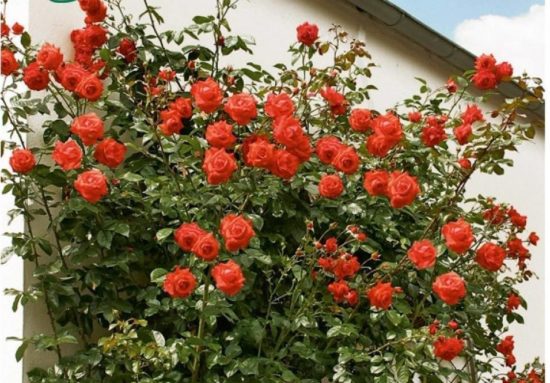

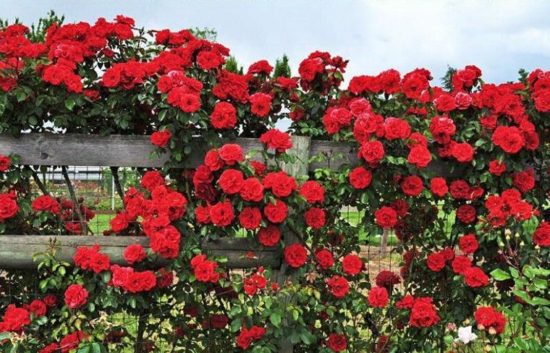
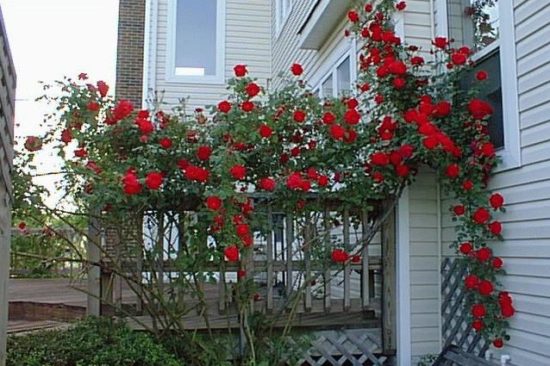
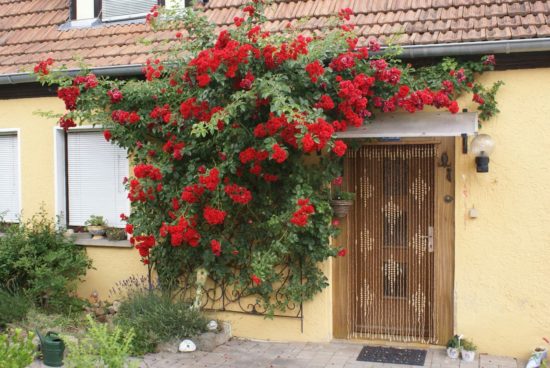
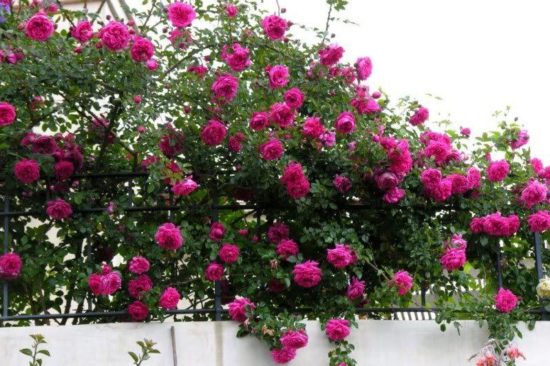
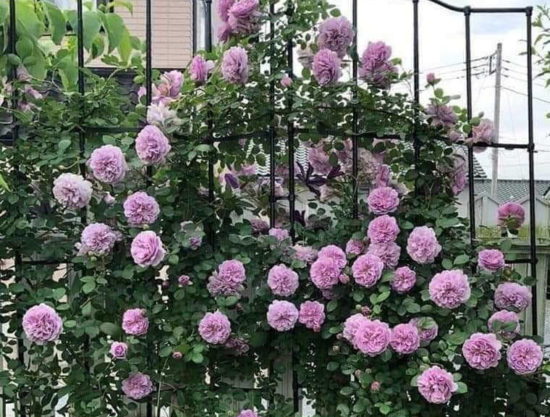
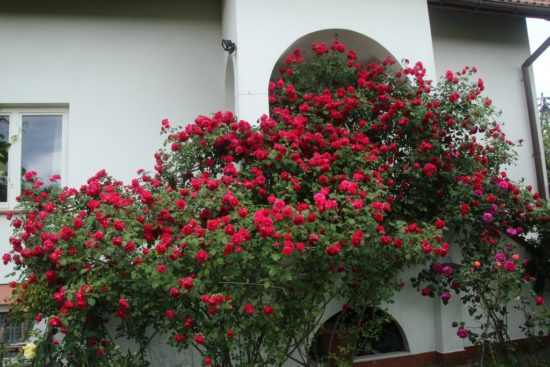
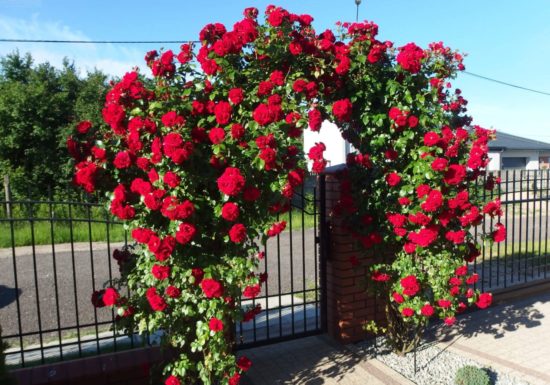

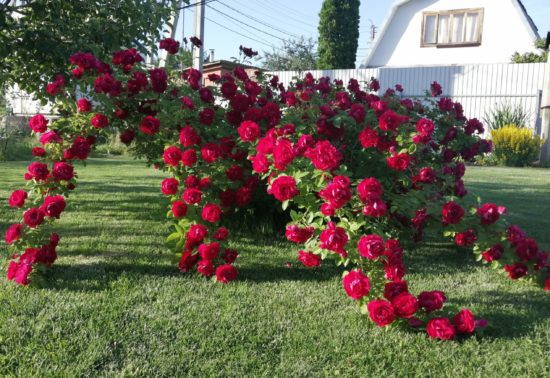
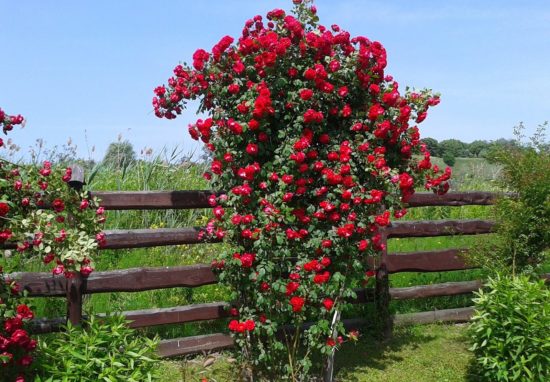
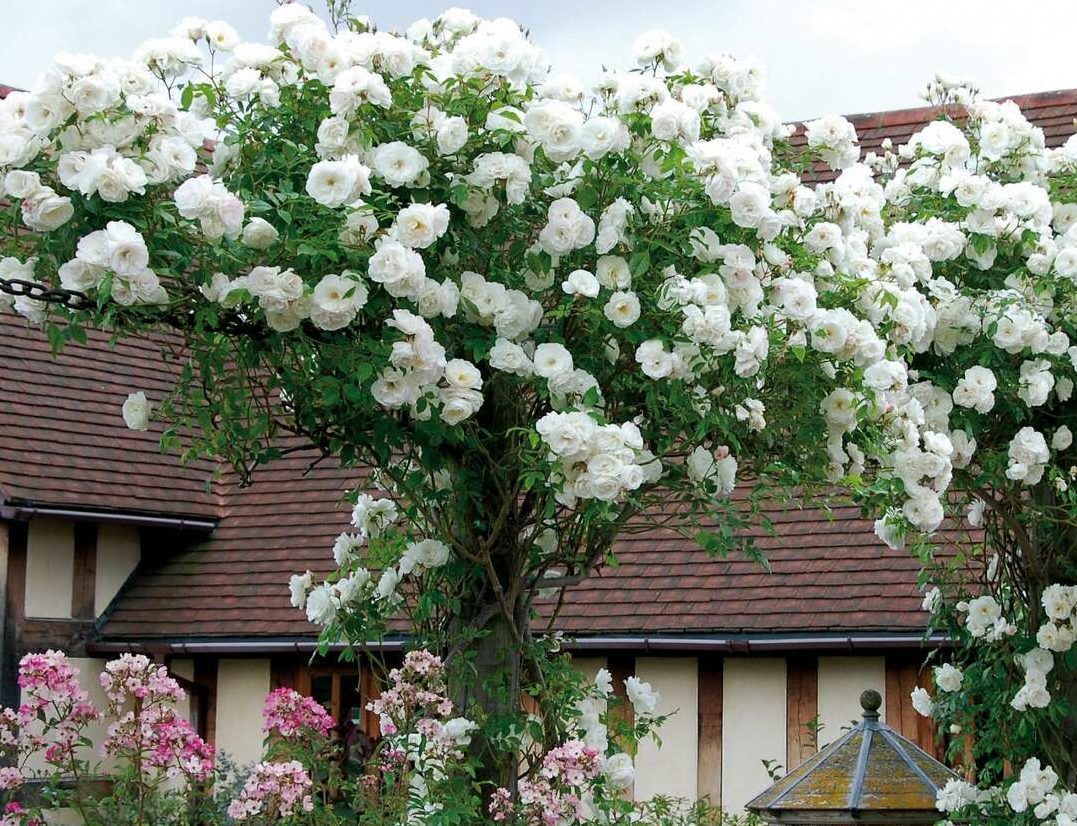
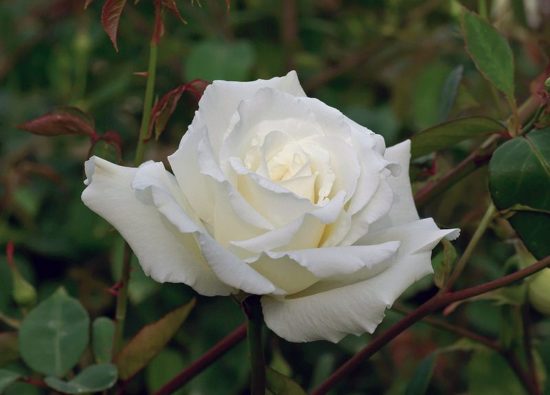
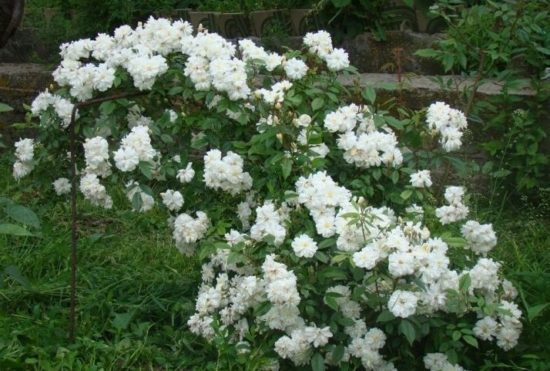
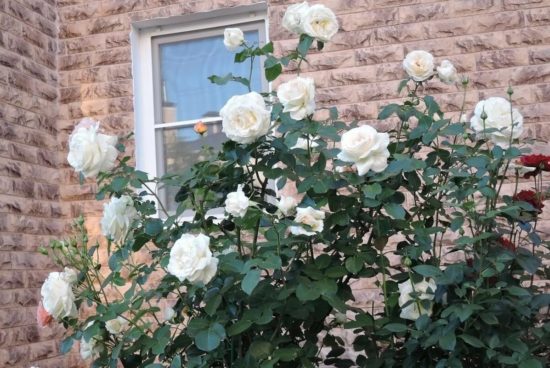
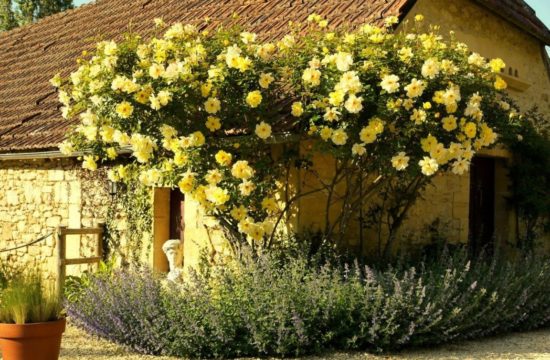
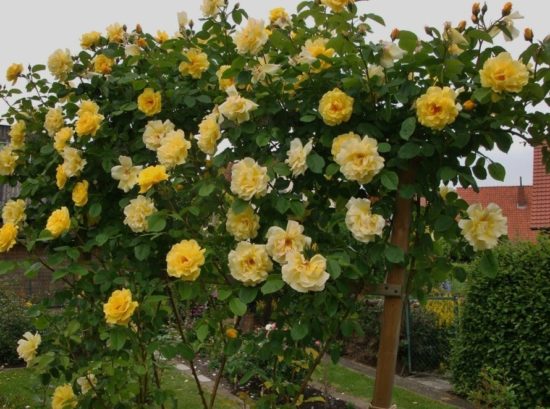
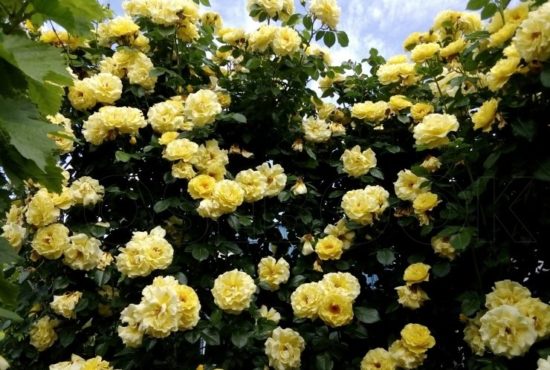
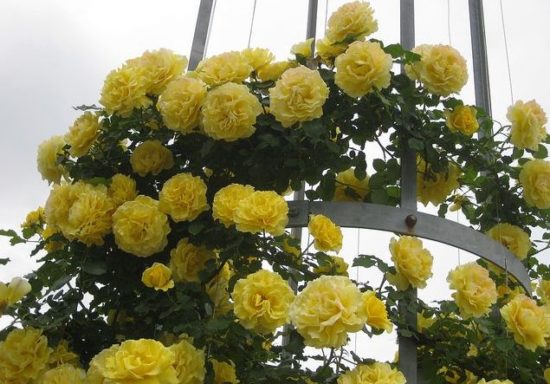
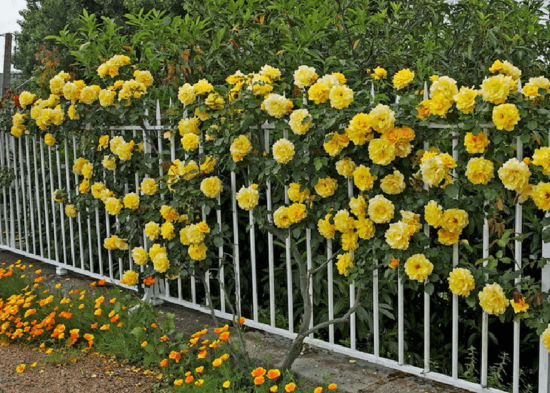
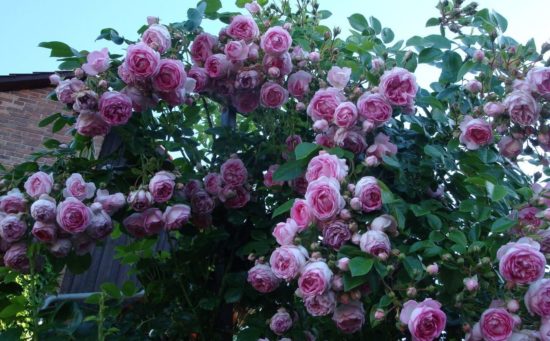
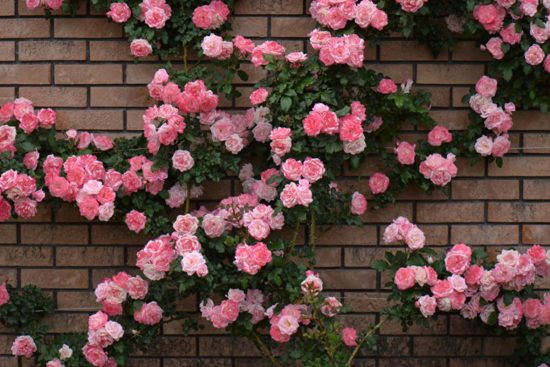
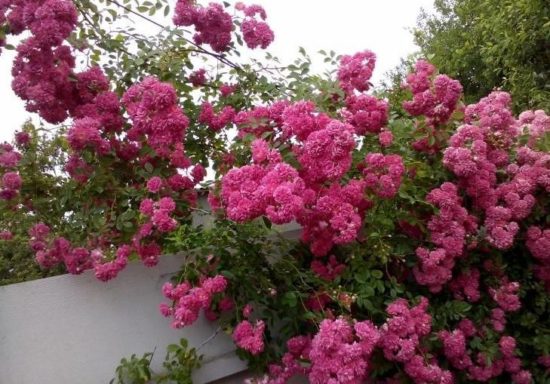


 (2 ratings, average: 4,50 out of 5)
(2 ratings, average: 4,50 out of 5) CUCUMBERS NEVER GET SICK, I'VE BEEN USING ONLY THIS FOR 40 YEARS! I SHARE A SECRET WITH YOU, CUCUMBERS ARE LIKE THE PICTURE!
CUCUMBERS NEVER GET SICK, I'VE BEEN USING ONLY THIS FOR 40 YEARS! I SHARE A SECRET WITH YOU, CUCUMBERS ARE LIKE THE PICTURE! You can dig a bucket of potatoes from each bush. Do you think these are fairy tales? Watch the video
You can dig a bucket of potatoes from each bush. Do you think these are fairy tales? Watch the video
 How our fellow gardeners work in Korea. There is a lot to learn and just fun to watch.
How our fellow gardeners work in Korea. There is a lot to learn and just fun to watch. Eye trainer. The author claims that with daily viewing, vision is restored. They don't charge money for views.
Eye trainer. The author claims that with daily viewing, vision is restored. They don't charge money for views. A 3-ingredient cake recipe in 30 minutes is better than Napoleon. Simple and very tasty.
A 3-ingredient cake recipe in 30 minutes is better than Napoleon. Simple and very tasty. Therapeutic exercises for cervical osteochondrosis. A complete set of exercises.
Therapeutic exercises for cervical osteochondrosis. A complete set of exercises. Which indoor plants match your zodiac sign?
Which indoor plants match your zodiac sign? What about them? Excursion to German dachas.
What about them? Excursion to German dachas.